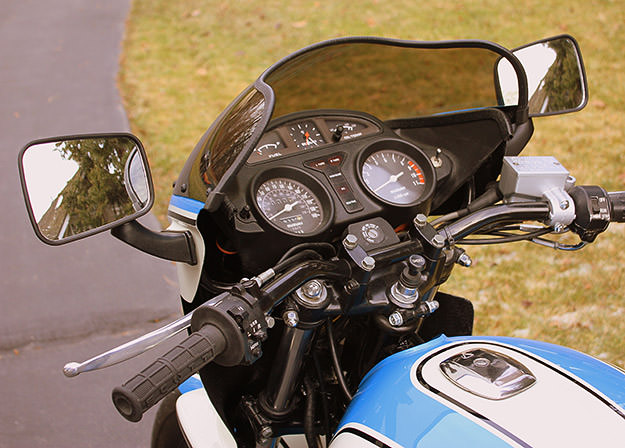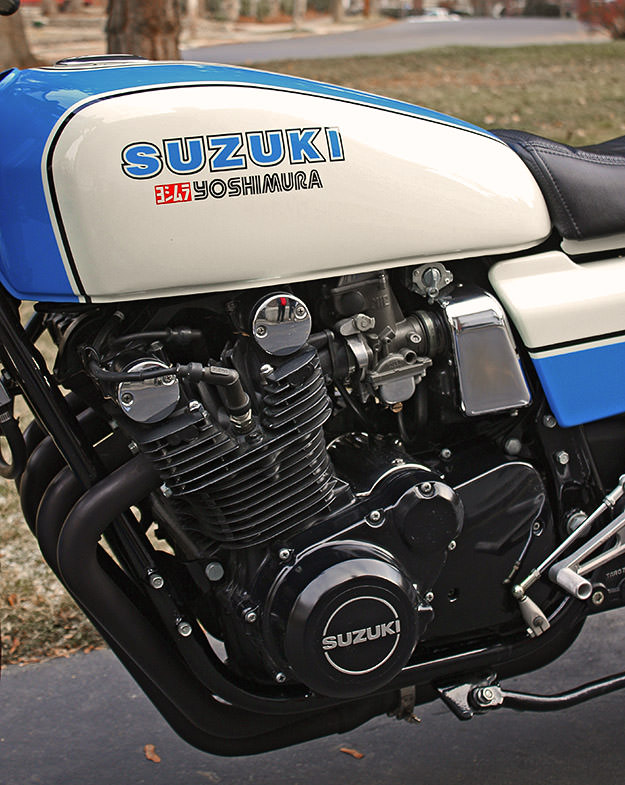They always play great music over their workouts which really gets you in the mood to get moving. My aim is not to get super ripped like they are as that wouldn't suit my body type. Also, to be quite honest, I like having womanly curves and would miss them should they disappear! So my plan is to use their workouts to tone myself up for summer. I just wish I could work out on the beach like they do! I could go work out on Aberdeen beach but I would have to wear a wooly jumper to do so!
Friday, April 29, 2011
The Royal Wedding, Dupe List, Exercise & Summer Sandals
They always play great music over their workouts which really gets you in the mood to get moving. My aim is not to get super ripped like they are as that wouldn't suit my body type. Also, to be quite honest, I like having womanly curves and would miss them should they disappear! So my plan is to use their workouts to tone myself up for summer. I just wish I could work out on the beach like they do! I could go work out on Aberdeen beach but I would have to wear a wooly jumper to do so!
Gianmarco Magnani
Gianmarco Magnani
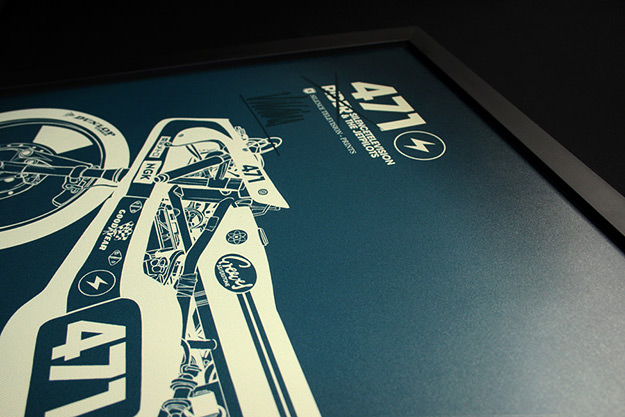
Peruvian artist Gianmarco Magnani has just released a series of prints featuring vintage motorcycles, and they’re knockouts—a mix of retro motorcycle manual illustration, cutting-edge typography and inspired line drawings. (A key influence is Katsuhiro Ôtomo’s sketches of Kaneda’s motorcycle from the movie Akira). Magnani prints his work on premium 270 gm photo paper, in limited editions of ten copies each, and sized at 100 cm square. “At first the series was just called ‘Riders’”, says Magnani. “But I decided to give it a focus of rivalry between good and bad, with another side: ‘Villains’.” It’s refreshing to see bikes illustrated in a contemporary way: if you’re not a fan of ghastly nostalgic watercolors or motorcycle art influenced by WWII aircraft nosecone girls, Magnani is your man. Check out his stylish website—which is also a textbook example of understated design and color coordination. [Images copyright © Silence Television. All rights reserved. Via Le Container.]
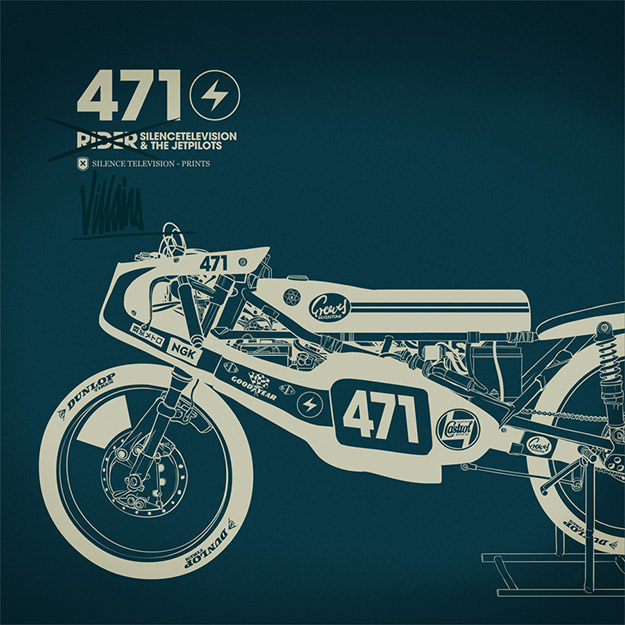
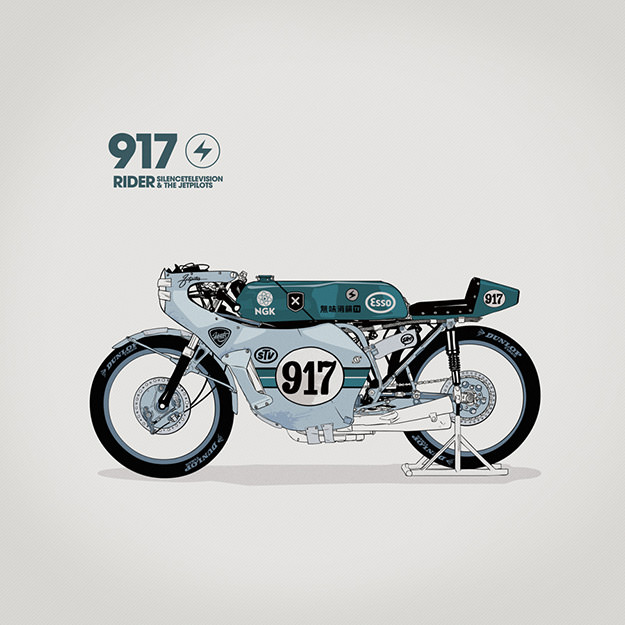
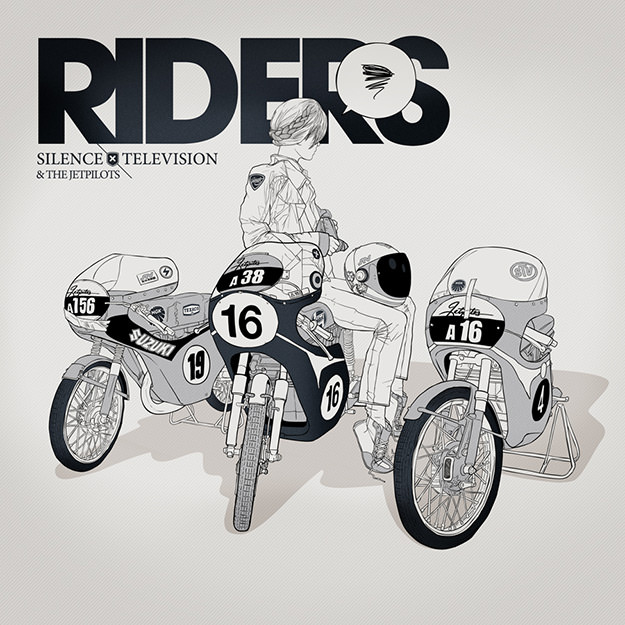
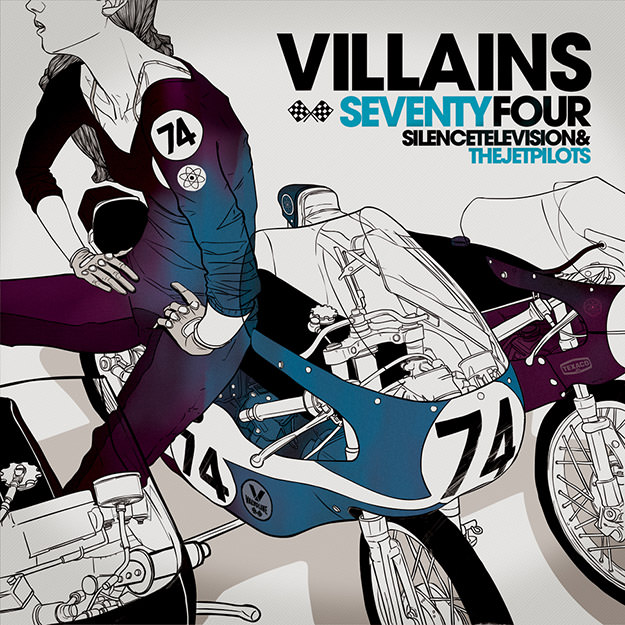
1980 Honda CBX custom
1980 Honda CBX custom
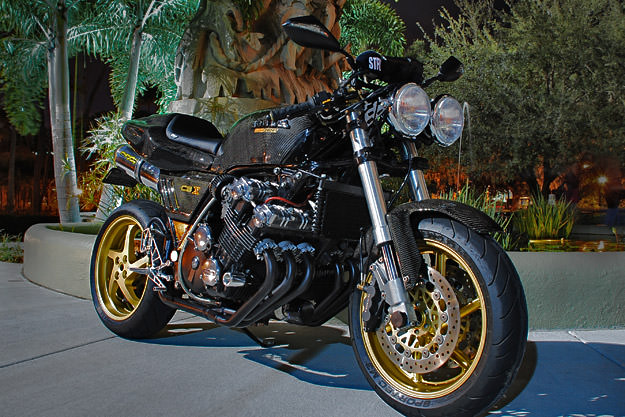
Rick Hayberg of
Sarasota, Florida, has worked in the auto industry for thirty years. And like a lot of riders, he was drawn back to a bike he’d seen many years ago. “I was fortunate enough to ride a brand new Honda CBX back in 1980, purchased by a good friend. Between the looks and sound that the CBX made, the bike remained stuck in my mind for many years. I bought my own CBX in 2008, and started my quest to create a classic old bike with the modern innovations found in the sportbikes of today.” Suspension, brakes, tires, and many upgrades followed. “My build was supposed to be a ‘budget’ build, but soon got out of hand.” Parts were recycled from Hondas, Suzukis, Yamahas and Kawasakis, with a few bits thrown in from Ducati. Even more amazingly, Rick did the entire build himself, in his garage at home. And that includes fabrication, welding, machining, electrical, paint and carbon fiber work. (The bodywork is not painted: virtually all the bodywork is 2×2 twill carbon fiber.) There are too many mods to list, but they include GSX-R750 forks and six-piston brake callipers, a VFR swingarm/wheel assembly, and
a Ducati subframe and tail section. “Because this was a naked bike, and because of my fondness for the Truimph Speed Triple’s looks, I had to go with the big dual lights up front.” One of the few things left untouched is that glorious CBX engine—a 1047 cc, 24-valve, DOHC air-cooled straight six with over 100 hp at the crank. With Rick’s suspension upgrades handling the twisties, this is a CBX that will leave many modern middleweight sportbikes in its dust.
many years. I bought my own CBX in 2008, and started my quest to create a classic old bike with the modern innovations found in the sportbikes of today.” Suspension, brakes, tires, and many upgrades followed. “My build was supposed to be a ‘budget’ build, but soon got out of hand.” Parts were recycled from Hondas, Suzukis, Yamahas and Kawasakis, with a few bits thrown in from Ducati. Even more amazingly, Rick did the entire build himself, in his garage at home. And that includes fabrication, welding, machining, electrical, paint and carbon fiber work. (The bodywork is not painted: virtually all the bodywork is 2×2 twill carbon fiber.) There are too many mods to list, but they include GSX-R750 forks and six-piston brake callipers, a VFR swingarm/wheel assembly, and
a Ducati subframe and tail section. “Because this was a naked bike, and because of my fondness for the Truimph Speed Triple’s looks, I had to go with the big dual lights up front.” One of the few things left untouched is that glorious CBX engine—a 1047 cc, 24-valve, DOHC air-cooled straight six with over 100 hp at the crank. With Rick’s suspension upgrades handling the twisties, this is a CBX that will leave many modern middleweight sportbikes in its dust.
C&J Rotax Flat Tracker
C&J Rotax Flat Tracker
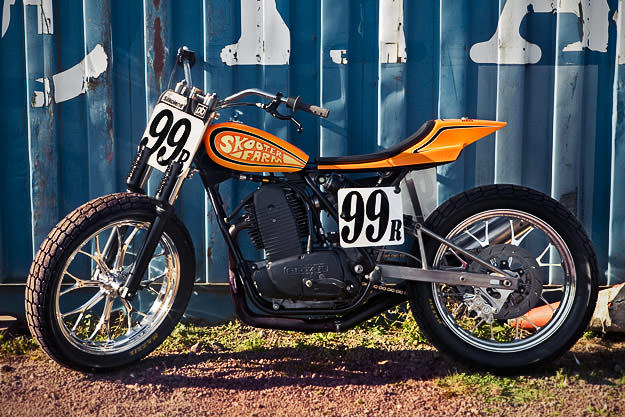
We’re suckers for flat track racing motorcycles here, and this Rotax-powered racer from England sure is purdy. The image comes from Ben Part of Sideburn, and Ben has his tongue firmly in cheek when describing the bike: “No vehicle is safe from the gaudy touch of the pimp and his bling. But only fellow gangsters, small children, and magpies are impressed with such shininess. So it’s a little strange for a novice UK short track rider to turn up with an imported American C&J-framed Rotax flat tracker—resplendent with PM forged wheels and brakes, and gold leaf lettering on the tank. And a feather duster. And then race it.” The rider wishes to be known only as Jason, letting his bike do the talking. And it looks the business: it’s using a C&J frame fitted with a Penske mono shock, plus front forks lifted from a Yamaha R6. Yokes are from A&A Racing and the fiberglass tank and seat unit is from Grand Prix Glassworks. Making sure the ‘go’ matches the ‘show’ is a 640cc 4-stroke thumper, prepped by dirt track guru Ron Wood. And Maxxis DTR-1 tires—ubiquitous but always attractive—put the power to the ground. According to Ben, “Jason gave himself the humble 99 number board ranking, knowing that he has no chance of a proud position on the podium any time this century. But most importantly he’s not afraid to look good losing.” [Sideburn #5 is out now, with 100 pages of “ass-kicking women racers, GSX-Rs on ice and Dave Aldana on dope”.
Triumph Trophy custom
Triumph Trophy custom
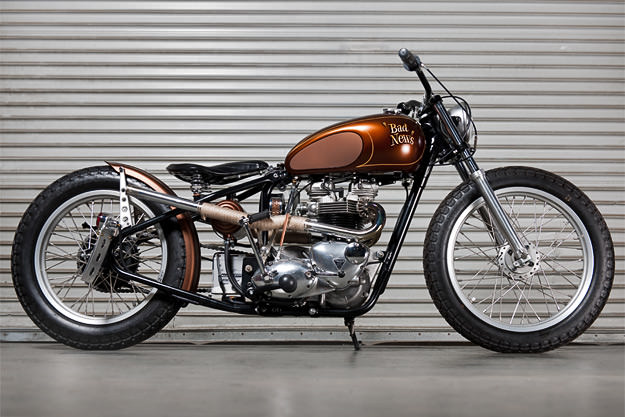
A few weeks ago, this beautiful Triumph bobber turned up on Chop Cult, one of the best old school custom sites. It’s a dirt-track influenced bike that attracted a lot of attention at last year’s David Mann Chopperfest; the word was that it was built by a guy from California called Jeremy Hoyer, but other information was scarce. So with a little help from Chop Cult’s Bill Bryant and Four Aces’ Wes White, I managed to track down and speak to the very helpful Mr Hoyer.
‘Bad News’ apparently started life as a beat-up, worn-out race bike that Hoyer found in a garage in Kentucky. He’s a mechanic for a dirt bike race team, and he wanted a bobber project to give himself a change of scene. “Being a race team mechanic is cool, but it gets boring building the same bike over and over again.” Bad News got its name from a conversation Hoyer had with his roommate, while staring at the bike the night Hoyer brought it home. “My roommate had asked what I knew about Triumphs and I replied, ‘Nothing, it’s probably all gonna be bad news!’ So, the name stuck throughout the build process.”
You’d never guess, but Hoyer had never built a bike from scratch before: “It was a great lesson in ‘what not to do’ … I tried to keep everything very simple and clean. I tried to reuse every original part I could. I didn’t want to lose any character or history associated with the bike. If it was OG and I could refurbish it, I did.” A lot of the look and feel of the bike comes from Hoyer’s racing background; he describes the look he wanted as ‘vintage racey’. “I hope people enjoy the bike as much as I do,” Hoyer says. “It was fun to build, it’s a blast to ride, and I’m looking forward to my next project. I have a book full of ideas!” [Scroll down for more photos. Images courtesy of and © Steve Cox. Email.]
Nikon D3X | 1/160s | f/4.4 | ISO 50 | Focal length 48mm
Tech sheet
Fabrication by: Jeremy Hoyer and Matt @ Haze City Fabrication
Year: 1969
Make: Triumph
Model: TR6R
Engine
Year: 1969
Builder: Jeremy Hoyer and John @ Countryside Cycle
Ignition: Boyer CDI
Displacement: 650cc
Transmission: 4 Speed
Carb: Amal Concentric
Frame
Year: 1969
Make: Triumph Main and Dave Bird Hardtail
Rake: Std.
Stretch: Hardtail 4”/2.5” drop
Fabrication: Jeremy Hoyer
Front End
Type: Triumph disc
Builder: Jeremy Hoyer
Modification: 2.5” shorter internals, caliper lugs machined, 135mm travel
Triple Clamps: Std. Triumph
Paint
Painter: Kelly & Son (The Crazy Painters)/Mitch Kelly
Type: PPG
Color: Matte Root Beer/Copper Brown
Pinstripe: Kelly & Son (The Crazy Painters)/Tom Kelly
Accessories
Bars: Renthal 971
Risers: Std. Triumph
Hand Controls: Std. Triumph
Gas Tank: Std. Triumph
Rear Fender: 5” ribbed
Seat: Biltwell Tuck & Roll
Front Controls: Std. Triumph
Oil Tank: Via Wes @ Four Aces Cycle Supply
Tail Light: Garage leftover from another project
Headlight: Swap meet
PS: Join the Bike EXIF Facebook page for more vintage motorcycle goodness.
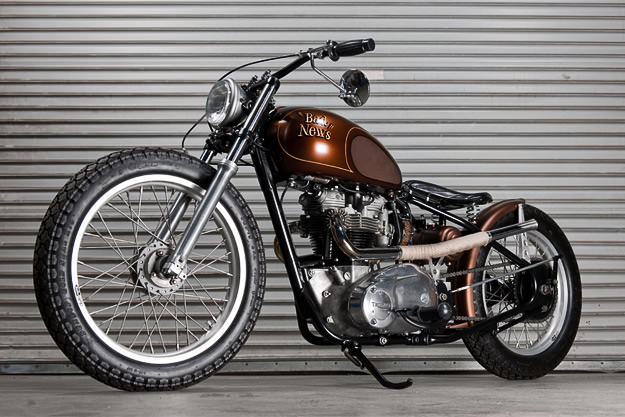
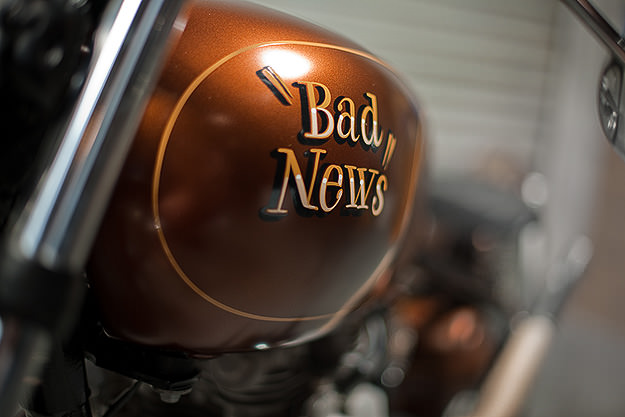
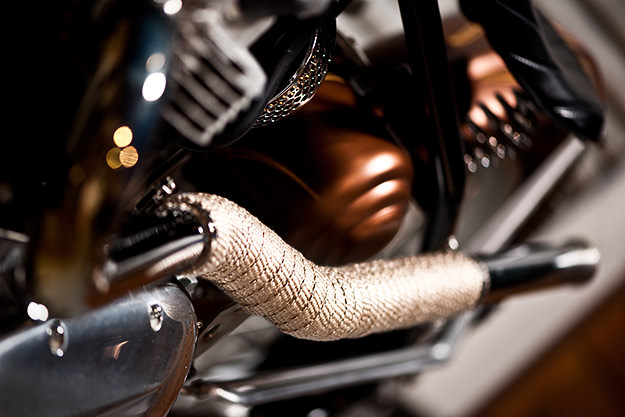
Icon Sheene
Icon Sheene
![]()
UPDATE 19 August 2010: Icon has revised the styling of the Sheene. The latest images are on the Icon website.
By guest writer Tom Stewart. Looking for the world’s most powerful and expensive production road bike? Well look no further, because according to the newly formed, Nottinghamshire-based manufacturer Icon Motorcycles, it’s the 250+bhp, £107,000 Icon Sheene.
First revealed at the recent Goodwood pre-season media day, this arresting machine is British businessman Andrew Morris’ vision, now a running reality, of the ultimate road-going motorbike and a tribute to his boyhood hero; the late, great Barry Sheene. Endorsed by Sheene’s widow Stephanie and by ex-team mate and best mate Steve Parrish, just 52 Icon Sheenes are planned to be built—one for each year of Barry’s life.
When it was put to chief Icon test rider Parrish that £107,000 (US$160,000) was ‘quite a lot’, even for a 200 mph motorcycle, he replied, “If you look closely then you can see the value”. So, let’s look closely. The engine is a hand-built, Garrett turbocharged Suzuki GSX1400 air-cooled lump (because it looks like an engine) with Carrillo rods, Wiseco pistons and other competition-spec internals. 250bhp with 133lb/ft is claimed at the rear wheel, even in lowest (0.4bar) boost mode. This is wrapped in an all-aluminum, purpose-built Spondon tubular frame complemented by an aluminum Fabrication Techniques swing-arm with Bitubo rear suspension and usd forks.
With carbon-fiber race wheels, ISR calipers, discs and levers, hand-laid carbon-fiber bodywork, a handmade aluminum tank, twin hand-crafted aluminum oil coolers, a handmade stainless exhaust, Bosch Motronic engine management (with custom mapping and datalogging), digital instrumentation, keyless starting and F1-spec wiring throughout, this is obviously no bargain basement machine.
The Icon also flaunts detailing to further woo wealthy buyers such as etched and engraved plaques and yokes, a hand-painted 1940s style pin-up girl and Sheene’s lucky no.7 embroidered into the heart-shaped alcantara bum-stop.
So: powerful, fast and expensive it undeniably is. But could this Icon also be a gauche, mildly exploitative, over-priced white elephant, much of which—frame, engine and styling—wouldn’t have been cutting-edge twenty years ago? You decide.
![]()
Yamaha XS650 cafe racer
Yamaha XS650 cafe racer

A few months ago, one of the leading Australian motorcycling magazines was redesigned. (I shall avoid naming it to protect the guilty.) It was admittedly looking a little staid and nondescript, but now it’s worse—it’s virtually unreadable. Every page and every gaudy little detail is overcooked, clamoring for attention. So I now leave it on the newsagent’s shelf. I was reminded of this principle when I saw this lovely café racer, because form over functio n applies to motorcycles as well as the magazines that feature them. Unless you’re a fan of Harley full-dresser aesthetics, bikes invariably look better when they’re pared back to the bone. And so it is with this lovely Yamaha XS 650. Built by Chris from Limey Bikes, a Texas-based builder, it’s nicknamed ‘The Hornet’. The stripped-down parallel twin weighs less than 160 kg—about 350 lbs—and packs an engine boosted from 53 to 70 hp. The spec sheet reveals that the bike is running superlight Excel 18” rims, progressive rate springs, an alloy swing arm and Brembo brakes. To upgrade the motor, Chris used a 750 cc kit and a Shell No.1 race cam; stainless steel and titanium valves are set into a gas-flowed head, and drink through Mikuni RS36 flatslide carbs. Everything that does not have a purpose has been removed, from frame tabs to miscellaneous wiring, and the bike is all the better for it. I used to think it was Colin Chapman who said, “Simplicate, and add lightness” and although he wasn’t the first—it was Ed Heinemann, creator of the Douglas A-4 Skyhawk—there’s a small-scale builder just north of Austin who knows more about design than a certain publishing company. [With thanks to Ted of xs650chopper.com.]
n applies to motorcycles as well as the magazines that feature them. Unless you’re a fan of Harley full-dresser aesthetics, bikes invariably look better when they’re pared back to the bone. And so it is with this lovely Yamaha XS 650. Built by Chris from Limey Bikes, a Texas-based builder, it’s nicknamed ‘The Hornet’. The stripped-down parallel twin weighs less than 160 kg—about 350 lbs—and packs an engine boosted from 53 to 70 hp. The spec sheet reveals that the bike is running superlight Excel 18” rims, progressive rate springs, an alloy swing arm and Brembo brakes. To upgrade the motor, Chris used a 750 cc kit and a Shell No.1 race cam; stainless steel and titanium valves are set into a gas-flowed head, and drink through Mikuni RS36 flatslide carbs. Everything that does not have a purpose has been removed, from frame tabs to miscellaneous wiring, and the bike is all the better for it. I used to think it was Colin Chapman who said, “Simplicate, and add lightness” and although he wasn’t the first—it was Ed Heinemann, creator of the Douglas A-4 Skyhawk—there’s a small-scale builder just north of Austin who knows more about design than a certain publishing company. [With thanks to Ted of xs650chopper.com.]
Harley-Davidson Pea Shooter
Harley-Davidson Pea Shooter
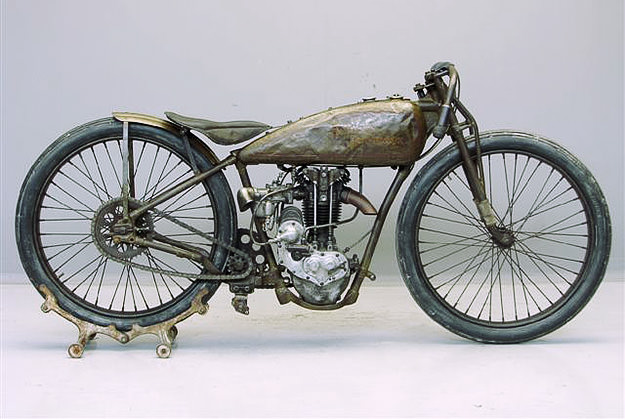
To my eyes, many of the most desirable Harley-Davidson vintage motorcycles are those that were built between the Wars. And not just the heavy machinery: the lightweight racing ‘Pea Shooters’ had an elegant style that has worn well over the years. These very rapid singles came into being after the AMA launched a ‘21 cubic inch’ racing class in 1925; Indian was ready, with its Prince model, but Harley was not. So Milwaukee got its skates on, and within months had designed and built two new singles. One was a side-valve flathead, and the other was an overhead-valve. The ‘S’ was the racing version of the OHV, with an innovative detachable cylinder head, and that’s what you’re looking at above. The bikes were known as ‘pea shooters’ on account of their distinctive popping exhaust note, and they cleaned up on the flat tracks of the day—both in the US and abroad. Weighing a mere 98 kg (215 lbs), the highly tuned engines nudged the S models towards the magic ‘ton’. Which in those days, was a remarkable achievement. Many of these supposed race bikes ended up as road machines; they became a popular choice for enthusiasts in Europe, and some were even used as everyday bikes. This particular example, a 28S in excellent condition and with a lovely patina of age, lives in Holland. It’s for sale for €45,000 (US$60,000) at the dealer Yesterdays, which is a veritable treasure trove of vintage motorcycles and worth a browse if you have a few minutes to spare. [Via Loudpop Voyager.]
Honda CB450 K1
Honda CB450 K1
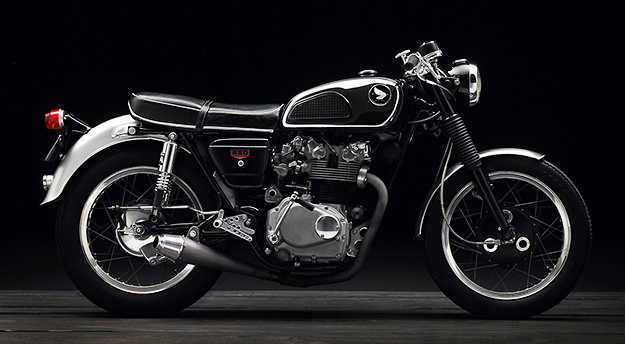
In the days before the horsepower race, the Honda CB450 was one of the most desirable bikes you could buy. You had the choice of charismatic, cantankerous British iron, which would invariably mark its territory with a little puddle of oil, heavyweight American cruisers, or the jewel-like build quality and supreme reliability of a Honda. This 1968 CB450 is one of the 6,000-or-so early K1 models, with a simple ‘450’ badge on the side panels, beneath a textured black vinyl seat with delicate white piping. The fuel tank was different to the ‘Black Bomber’ K0 models introduced in 1965, and the K1 was an altogether more attractive and contemporary-looking model. The example featured here was restored by the talented Jean-Claude Barrois, a welder by profession and friend of the Southsiders collective; Barrois has subtly modified this CB450 to add a sportier touch, creating new rearsets and fitting a redesigned exhaust. (The bike has now been sold, and the new owner plans to add a period-correct Avon fairing.) The excellent photography, by the way, is from Guerry & Prat Images, a new studio that is shaping up to become one of Europe’s leading motorcycle photography specialists. [With thanks to Vincent Prat.]
Phase One | H25 back | 22MP | ISO 100
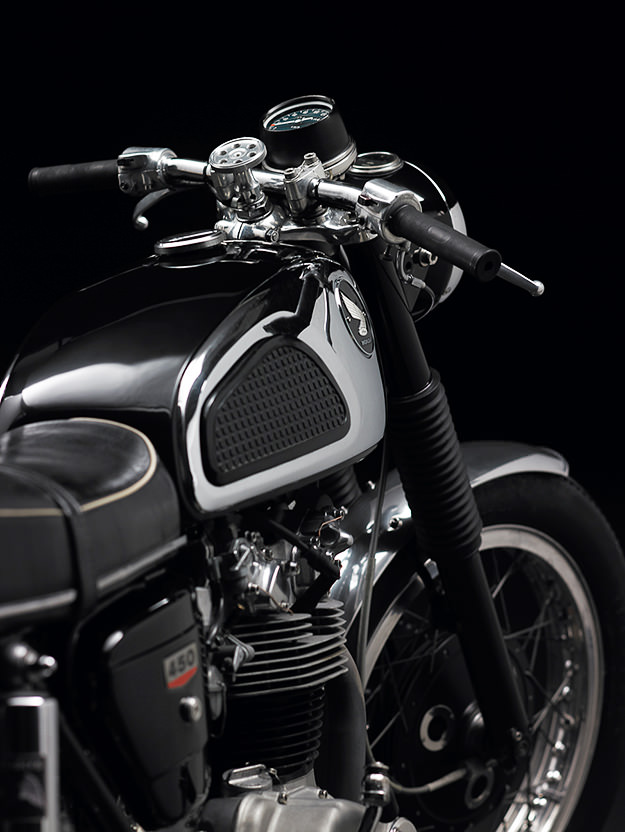
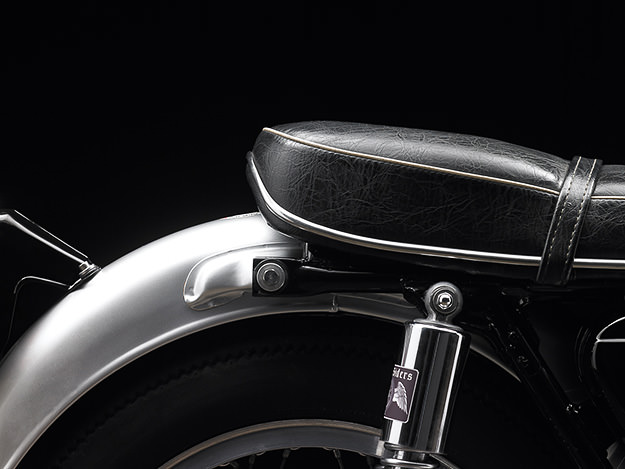
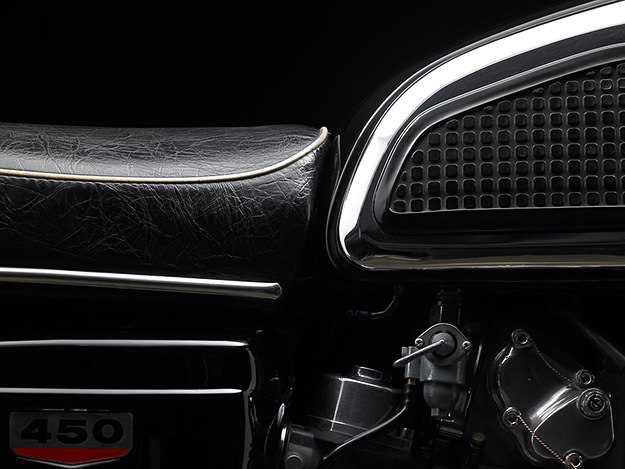
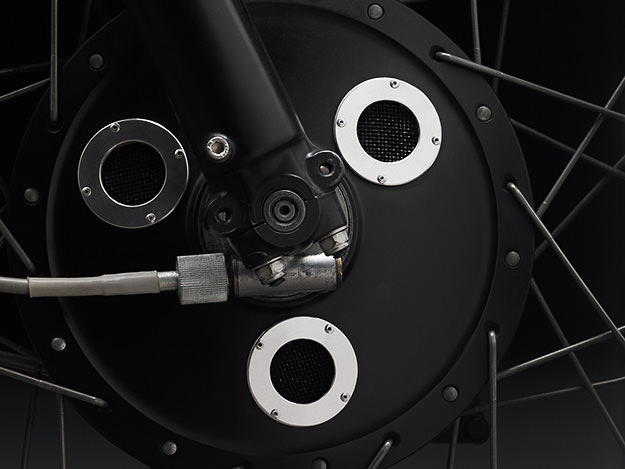
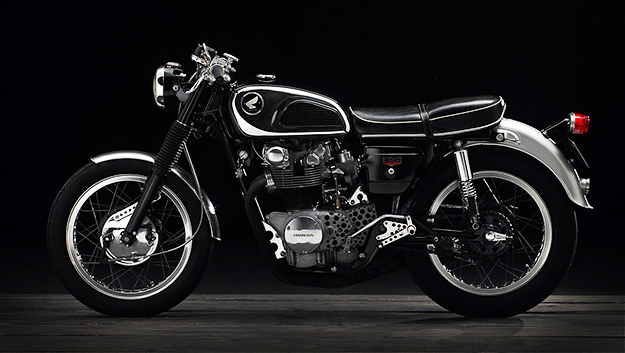
Schnaller Greymouth Thruxton
Schnaller Greymouth Thruxton
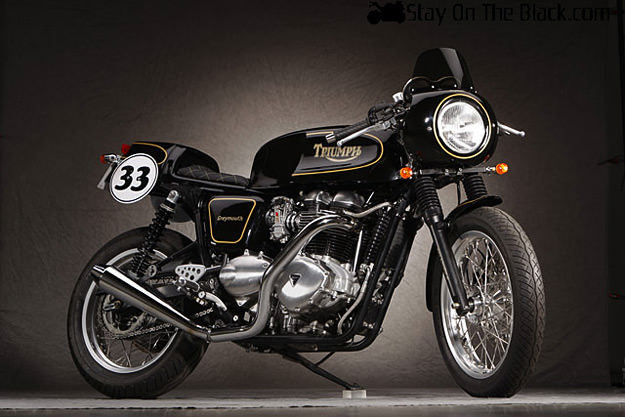
Here’s a sweet-looking machine for a weekend ride. The Austrian motorcycle dealer Jürgen Schnaller has taken a stock Triumph Thruxton and fitted a café racer body kit from Airtech Streamlining—creating what he calls the ‘Greymouth Thruxton’. The Airtech kit includes a Triton-style tank and seat, a Lucas taillight, a bobbed front fender and a Manx-style flyscreen. On the mechanical front, Schnaller has fitted the 865 cc Thruxton motor with high compression pistons, high lift cams, and a ported and polished head. The carbs are upgraded to flat side Keihins, with a Swedish Raask exhaust giving even more of a performance kick. The result is a reported 26 bhp increase over the stock bike’s somewhat anaemic 68 bhp, and the front and rear suspension has been upgraded with Wilbers components to cope. If you followed motorsport in the 70s and early 80s, you’ll recognise the livery: it’s a John Player Special design, as used by the Lotus Formula One team. JPS was also one of the first major brands to sponsor a motorcycle racing team, but not Triumph: it bankrolled Norton’s Formula 750 bikes from 1972 to 1974, although not in these colors. Even though the choice of paint scheme may be a little strange, the result is even more attractive than the stock Thruxton—don’t you think? [Via Blood Falcons.]
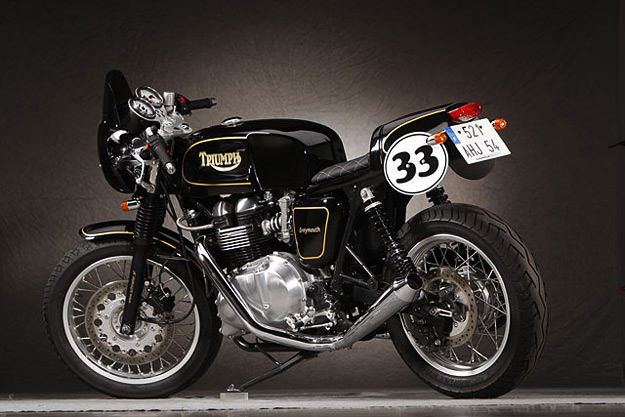
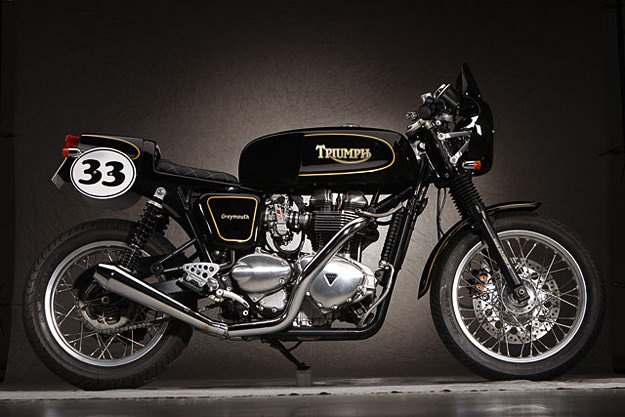
Kawasaki H1
Kawasaki H1
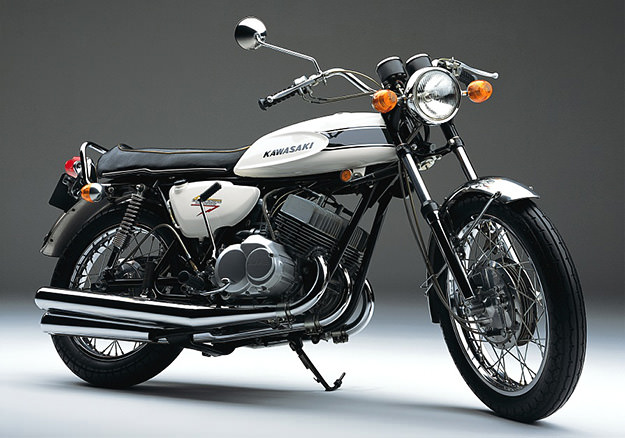
Forty years ago, sport bikes didn’t have ABS or traction control or electronically controlled suspension. They had too much power, and that power was often delivered with a thumping two-stroke jolt. Kawasaki’s iconic H1 Mach III 500 is the classic example, and even by the standards of today’s motorcycles, it’s a fearsome beast: riders who survived the inevitable highside would joke about the ‘double-hinged’ frame. The drum brakes were no match for the highly-tuned air-cooled triple, which could power the H1 down the quarter mile in just 12.4 seconds and on to 200 kph. The images shown here were taken to celebrate the fortieth anniversary of the H1, and in this case, pictures do indeed speak a thousand words. So I’ll leave it at that. [Thanks to Scott Hopkin, Tom Stewart, Dimitri Michels and Raymond Moore of Optikal Blitz for helping in the search for definitive H1 images. See the full gallery on Motosblog.fr. Via HFL.]
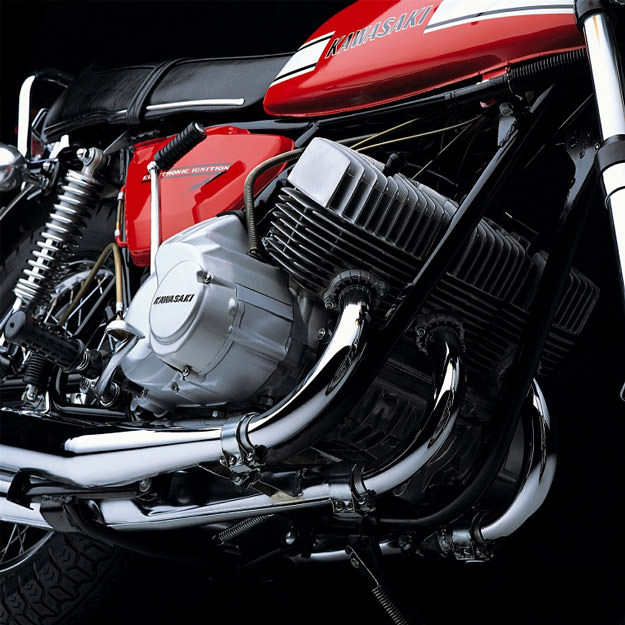
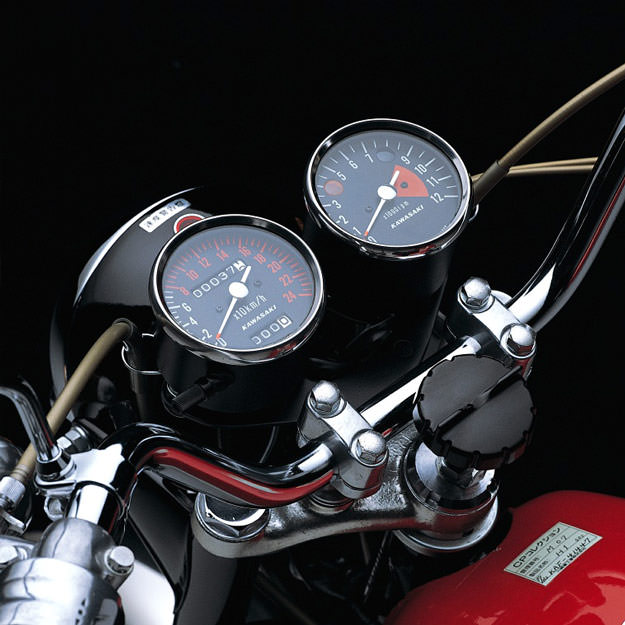
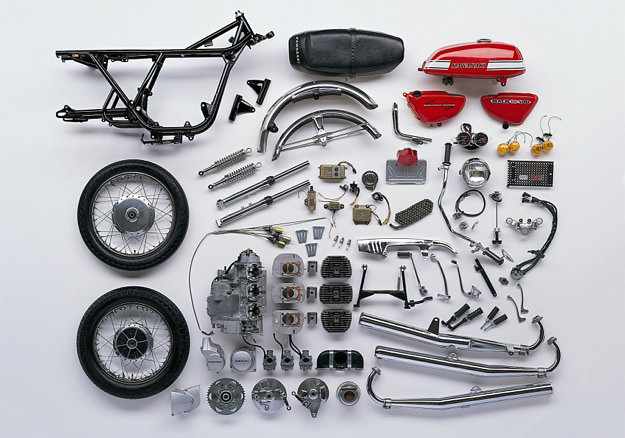
BSA A10 Super Rocket
BSA A10 Super Rocket
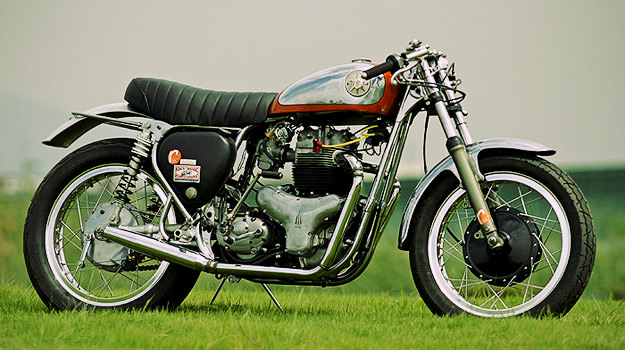
Here’s a classic example of a very tasteful ‘resto-mod’, and one that shows off the lines of the BSA A10 beautifully. The iconic A10 first appeared as the 1949 Golden Flash, but by the mid 50s, the range needed an overhaul. BSAs were being seen as rugged and reliable, while Triumph and Norton fought the performance war. So BSA upgraded its mainstay platform to produce the Road Rocket, and then in 1957, revealed the even faster Super Rocket. The top end of the A10 engine was reworked, and a large Amal TT racing carburettor fitted. The result was impressive: a top speed of around 112 mph (180 kph), with the quarter mile coming up in a whisker over 14 seconds. The pictured Super Rocket is 1960 model from the top Japanese workshop Ritmo Sereno: they’ve bored out the 646 cc air cooled twin to 683 cc, balanced the conrods and crankshaft, and fitted a Boyer ignition and new exhaust system. Ritmo also upgraded the brakes—still drums for authenticity—and fitted RK Excel wheels shod with Dunlop K300GP tires. All they need to do now is fit a headlight, and the bike’s ready to roll.
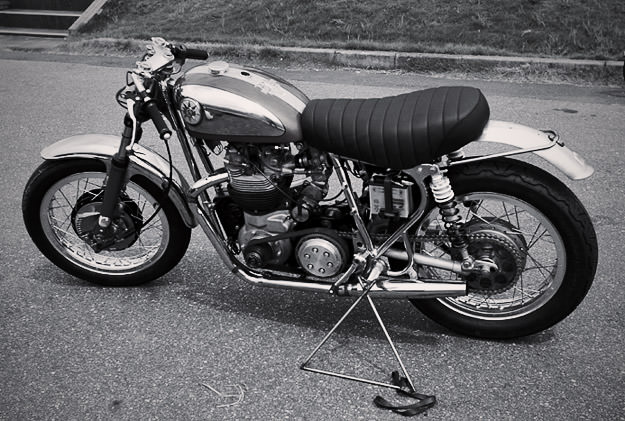
Sponsor intro: Vitesse Moto
Sponsor intro: Vitesse Moto

Today is a big day for Bike EXIF: we have our first site sponsor, the new premium motorcycle boot maker Vitesse Moto. We’re especially pleased because Vitesse Moto is a great fit for our philosophy, as well as helping to secure the future of Bike EXIF. Founder John Mollanger shares our interest in iconic motorcycles and aesthetic design:
“It’s not just about the bike—whether it’s an Italian twin, a Japanese four or an English triple. It doesn’t matter if it’s recent or pre-war, a commuter in the garage or a classic in your living room. It’s about the passion for motorcycles and having a love for all things special. It’s about motorcycles as a form of art, and talking about them like others might talk about wine.”
Vitesse Moto boots are engineered for performance, but comfortable enough to be worn every day. And there’s no compromise on safety levels. Vitesse has created ‘V-Cockpit’ technology, a patented ankle management device that gives you the best possible protection-to-comfort ratio: “Our ambition at Vitesse Moto is to help you live your passion with style and safety,” says Mollanger.
There are three boots in the Vitesse Moto range:
![]() Hunt Inspired by traditional work boots, Hunt gives riders a great dose of comfort and protection. Featuring an American saddle leather upper with adjustable lace–up construction. €175.00 (around US$235).
Hunt Inspired by traditional work boots, Hunt gives riders a great dose of comfort and protection. Featuring an American saddle leather upper with adjustable lace–up construction. €175.00 (around US$235).
![]() Glove A sleek, fitted piece of soft, breathable leather with racetrack features. For riders who want comfort through the day and the freedom to drag their knees on Sundays. €200.00 (around US$265).
Glove A sleek, fitted piece of soft, breathable leather with racetrack features. For riders who want comfort through the day and the freedom to drag their knees on Sundays. €200.00 (around US$265).
![]() Vulcan The lowest cut in the range, but still incorporating V-Cockpit technology. Inspired by vintage athletic sneakers, Vulcan uses a waxed canvas upper material. Just €150.00 (around US$200).
Vulcan The lowest cut in the range, but still incorporating V-Cockpit technology. Inspired by vintage athletic sneakers, Vulcan uses a waxed canvas upper material. Just €150.00 (around US$200).
Vitesse Moto boots are available worldwide and sold exclusively via a secure online store, with downloadable fitment tools to ensure accurate sizing. Check out the Vitesse range here; you can also find the company on Facebook and Twitter.

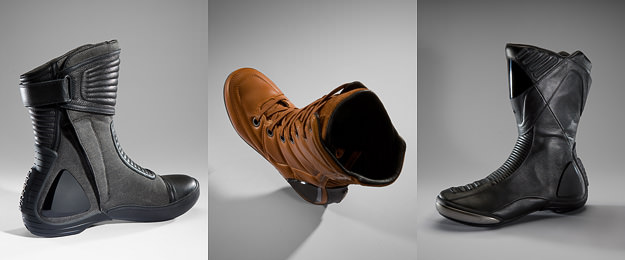
Honda CB550 cafe racer
Honda CB550 cafe racer


The Honda CB550 is one of our all-time favorite platforms for creating a café racer. Of the six Honda SOHC4 models made from 1969 until 1982, it seems to have the best balance of performance, size and agility. Introduced in 1974, it uses a 544 cc air-cooled 8-valve SOHC transverse four; in stock form, the 50 bhp output offered a top speed of 102 mph (164 kph). This particular bike has become a smash-hit on the excellent SOHC4 forum, with a detailed chronology of the super-thorough build provided by member Squirley. He gave his CB550 a complete overhaul, right down to an engine strip, rebuild and repaint, and it looks just delicious. [Thanks to Nick Venn for the tip.]
Suzuki GS1000S Cooley replica
Suzuki GS1000S Cooley replica
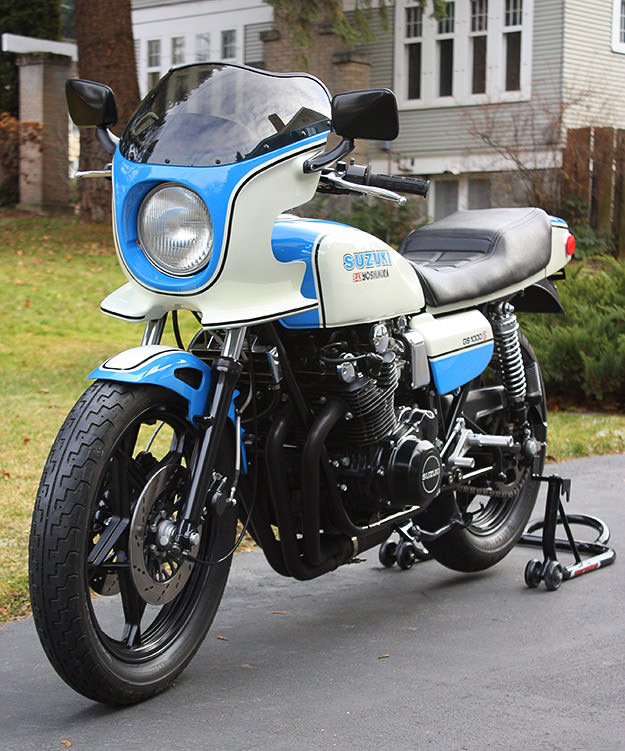
Today’s guest post is by Mitch Boehm, Editor & Publisher of Moto Retro Illustrated. It’s a common thread with us ’70s/’80s superbike guys. We either owned (and sold) or wanted one of the streetbikes we saw sliding around Laguna or Daytona beneath guys like Wes Cooley, Freddie Spencer or Eddie Lawson. Kawasaki KZ1000Rs. Honda CB900Fs. Or Suzuki GS1000Ss. Just looking at the nasty things made our blood boil, but for whatever reason many of us just couldn’t get—or hold onto—them in our youth.
Now, of course, more of us have the money, time and patience to source, restore, maintain and ride these legendary superbikes. And for many fans they provide massive aesthetic and road-going satisfaction.
Larry Pearson is one such enthusiast. After watching Lawson, Spencer and Cooley duke it out in the early ’80s at the AMA Nationals in the Pacific Northwest, Pearson had always harbored major-league lust for a Suzuki GS1000S—a limited-edition open-class superbike available in ’79 and ’80. Pearson finally found an S-model when buddy Devin Corbit bought one and got bogged down on its restoration. “Devin got tired of me whining about buying it,” says Pearson, “and since he needed money for his street rod project, he sold it to me.”
Pearson had always wanted to set up a 1000S with the Right Stuff—the stuff Cooley and the Yosh crew used on its racers: rearsets, low bars, a step seat, a Lockhart oil-cooler with lines running along the right side of the cylinder, and everything blacked out—with an era-correct Yoshimura header topping it all off. “The Yosh pipe took me over a year to find,” Pearson says, “and it’s mint. I’d have probably taken this bike back to stock had it not been for that pipe.”
With only 18,000 miles on the clock, Pearson’s S was mechanically sound—which he verified with help from Honda tech Charlie Brown. So he began his chassis customization with an engine removal and a complete strip and powder-coat of the frame, including replacing all seals, bearings and bushings once that work was done. Next came stainless brake lines, slotted discs from an ’80-spec GS1000S, a set of NOS mirrors, new cables, Conti Blitz tires, Tarozzi rearsets, and a new master cylinder. Pearson refurbished the wiring harness, and added a new subfender, piggyback Honda CB1100F shocks and a front fender from the same bike, which routed air right to the oil-cooler. “They’re pieces I always knew would look perfect on this bike,” Pearson says. “The fender has that cool spoiler on top, and it’s way lighter than the stock steel fender. I had to modify it, but it’s easily one of my favorite pieces.”
Pearson spent tons of time on his S’s aesthetics to get them perfect. “I painted the engine two shades of black,” he told us. “Flat for the cylinders, head and block, and semi-gloss for the valve cover and engine covers. I like contrast. Two blacks ensure the engine doesn’t look like it’s been ‘dipped’ in paint. I also painted the wheels, fork and everything else I could think of in satin and gloss black. Even the bars are powder-coated black.”
Though black dominates the engine and frame, the bodywork remains the traditional blue-and-white Suzuki/Cooley/Yoshimura livery. “The factory colors have always knocked me out,” he told us, “so I kept the original colors. It’s what makes the S-model what it is. I fixed several dents in the tank and a few cracks in the sidecovers and fairing. Then repainted everything in urethane, using factory Suzuki decals throughout. I also added the Yoshimura decal to the tank, and buried everything under ten coats of clear-coat for a finish the factory could only dream of. I also modified the seat by hacking two inches off the foam and reshaping it, so it’d flow into the tank more smoothly. Suzuki made some ugly seats, but this one looks right.” Royal Upholstery in Spokane covered it for Pearson in two textures, all with beautiful French seams. Much sleeker, he says, and still very comfortable.
The only glitch was the S-model’s hard-to-find dash assembly. “Unfortunately,” Pearson says, “part of the dash was broken off due to a tipover. I took a piece of a broken Kawasaki ZX-14 windscreen, found the correct curve from it, cut it to shape, bonded it to the Suzuki dash panel, and recovered it with matching vinyl. After a complete disassembly and cleaning, the stock dash looked brand-new.” Nice.
Pearson’s custom S-model took him more than 18 months from start to finish. But like most projects that involve this much thought, effort and passion, the end result is nothing short of stunning.
“This bike has been burning in my brain for three decades,” Pearson says, “and now I have one in my garage! It’s a dream come true. It rides, handles and runs as good as new, maybe even better. These bikes have a soul, and the sound of that Yosh pipe is pure music; it takes me right back to the early ’80s! It’s so much fun to ride, and it stops people dead in their tracks when they see it. ‘Whoa,’ they say, ‘that’s a freakin’ Cooley-replica Suzuki!’” Which is pretty much what we said when we first laid eyes on his S-model special.
[Thanks to Mitch Boehm. Get your subscription to Moto Retro Illustrated here.]
